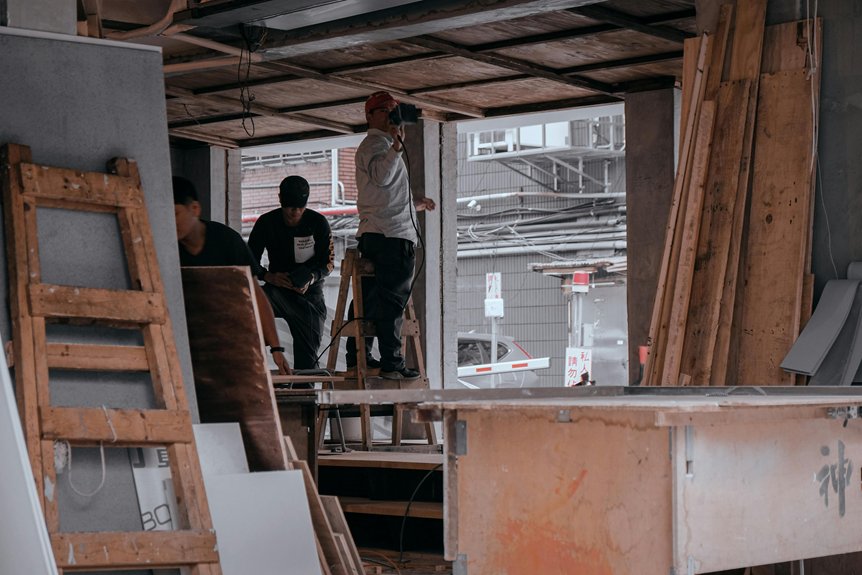Used scaffolding planks can be a cost-effective option if they are meticulously inspected for any signs of damage such as cracks, rot, or warping. Typically made from timbers such as pine or fir, these planks necessitate regular evaluations to ensure compliance with safety standards, particularly as they must support loads significantly exceeding the working weight.
Proper upkeep and thorough testing can help to prolong their service life. To guarantee safe usage, it is crucial to comprehend evaluation methods and adhere to safety guidelines. Further insights and detailed information are available for those who wish to delve deeper into this topic.
Types and Materials of Second-Hand Scaffolding Planks
Second-hand scaffolding planks are available in a variety of types and materials, each presenting unique benefits depending on their construction and composition.
Wooden planks are commonly crafted from high-quality timber such as pine, fir, or Southern Pine, and can be found in solid-sawn or laminated veneer lumber (LVL) forms. Wood offers a lightweight solution with excellent traction, making it user-friendly for workers. However, wood can be susceptible to environmental damage, including rot, cracks, and pest infestations. Proper maintenance and regular inspections can extend their lifespan and maintain safety standards.
Metal planks, typically made from steel or aluminium, are renowned for their strength and durability, making them suitable for extended outdoor use. Steel boasts a high load capacity, while aluminium is lighter and resistant to corrosion, albeit usually at a higher cost.
Composite planks combine wood fibres with plastic resins, creating a product that merges strength with weather resistance. Additionally, bamboo planks present a renewable and lightweight option often favoured in certain construction practices.
When selecting scaffolding planks, it’s essential to consider the specific requirements of your project, including load capacity, environmental exposure, and durability to ensure safety and efficiency on site.
Evaluating Condition and Safety Standards
Evaluating the condition and safety of scaffolding planks is a vital step before each use to prevent accidents and ensure the stability of the work platform. Inspectors should look for cracks, notches, warping, or rot, which can compromise the integrity of the wood. Daily visual inspections are essential, and any damaged planks must never be utilised. The density and grain orientation of the planks also play a significant role in their overall strength, making these factors crucial to consider. Regulatory bodies require that planks support a minimum of four times the intended load, and appropriate labels or certification should confirm this compliance. Mechanical testing, such as load or proof testing, can further validate the safety of scaffolding materials. Proper installation is equally important; planks must be securely placed on bearers and spaced correctly to maintain stability. Regular maintenance, combined with adherence to safety standards, is key to protecting workers and ensuring a safe working environment. Adequate training ensures that workers know how to identify potential hazards during inspections and handle scaffolding components correctly.
Benefits and Risks of Purchasing Used Planks
Purchasing used scaffolding planks can provide significant cost savings and swift access to materials, making them a compelling option for numerous construction projects. The initial expenditure is generally lower compared to new, certified or specialised planks, allowing for greater budget flexibility for other project requirements. Additionally, buying used planks can diminish waste and disposal costs by reusing existing resources. However, there are inherent risks associated with this choice. Hidden damage from prior misuse or environmental factors may compromise the wood’s strength, posing potential safety hazards. Used planks are often inspected before resale to ensure compliance with safety standards, but this does not always guarantee their structural integrity.
- Cost savings can enhance project budget flexibility or increase profits.
- Risks involve compromised structural integrity and potential safety concerns.
- Durability may be limited, particularly if proper treatment or storage precautions aren’t observed.
When selecting used planks, it’s essential to weigh the financial advantages against safety considerations to ensure both successful and secure working environments.
Best Practices for Reusing and Recycling Scaffolding Components
To maximise the lifespan and usefulness of scaffolding components, construction teams should adhere to established best practices for reuse and recycling. Steel and aluminium parts can be assembled and disassembled multiple times without losing strength, promoting repeated use across various projects. Recycling metals like steel and aluminium helps reduce pollution and conserves natural resources, which further supports sustainable construction practices.
Modular scaffolding designs facilitate easy adaptation and minimise waste, benefiting the environment.
Proper planning and accurate estimation are essential in preventing excess orders and reducing leftover materials. Regular inspection and maintenance help identify any damage, extend the service life, and ensure safety during reuse.
Standardised, interlocking parts enhance compatibility, making the process of reuse smoother.
Recycling metals such as steel and aluminium mitigates environmental impact, conserves resources, and decreases carbon emissions. Industry guidelines provide safety standards that support responsible reuse and recycling throughout the construction process.
Conclusion
Purchasing used scaffolding planks can be a financially sensible and environmentally friendly option, provided they adhere to safety standards and are in satisfactory condition. It is vital to inspect the materials thoroughly, looking for any signs of damage, and to adhere to best practices for reuse and recycling.
While there may be inherent risks associated with reused planks if they are not inspected correctly, when managed appropriately, they can deliver dependable performance while also contributing to sustainability efforts. Ultimately, a careful evaluation not only guarantees safety but also ensures that you remain mindful of your budget and ecological responsibilities.
By making informed decisions regarding used scaffolding planks, you can achieve a balance between cost-effectiveness and environmental stewardship.

